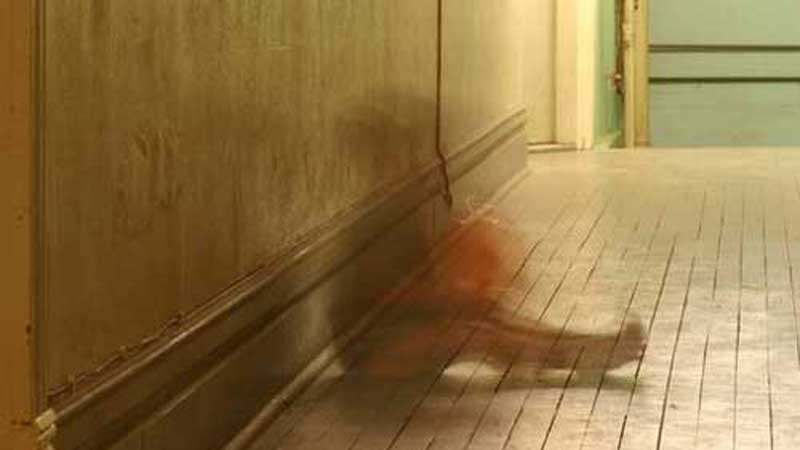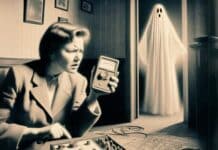Guest writer ALAN MURDIE, chairman of The Ghost Club, tells us not to worry about keeping ghosts hidden from children, they’ve probably already seen them

Surveys indicate that there is no specific age for seeing ghosts. “A child of eight is just as likely to see a phantom as a person of eighty,” was the view of Andrew Green for 60 years, one of Britain’s leading ghost hunters, who once conducted a survey in an effort to establish whether children were more likely to see apparitions than adults.
Some details were included in his Mayflower edition of his classic Ghost Hunting: A Practical Guide (1976) which was a key influence in the 1970s in encouraging many youngsters 1970s (myself included) to take up the investigation and study of ghosts.
The total number of children questioned by Green 125, ranging between the ages of 6 and 12 years. Of the 125, 65 (over 50%) described human figures that they had seen, in some cases several times, but which were not apparently visible to their parents.
At least 27 of the 65 descriptions were found to match those of people who had once occupied the child’s current home, though unfortunately Green was unable to establish if more than nine of the 27 people described were deceased.
Today as an adult when investigating hauntings in family homes, I sometimes met parents who rather sheepishly mention “the children” and say, “We want to keep it from them and don’t want to frighten them.”
If the ghost is of the average type (if there is such a thing) then the children will probably have experienced it already and taken it in their stride. Nervous parents are inclined to make nervous children. It is only when fright or agitation is outwardly shown by the adults that the child will need comforting.
If the incidents are treated as “normal” events in the household, and many people learn to accept them as such, then the tension will gradually disperse – such cases the ghost may also be a cause of excitement and interest to children and a ghost hunt – if conducted sensibly and safely – will often be thrilling fun.
Sometimes the particular apparition will only be seen once by a child. This often seems to occur when a child sees a ghostly figure that is recognised as a family member, usually grandfather or grandmother or other older relative. Their figure may be seen by a very young child of two, three or four years of age at night.
These experiences typically occur in bedrooms; what often suggests a psychic experience rather than a dream is that such sightings may coincide in time very closely with the death of the older relatively concerned, despite details of any illness or such event being unknown or kept from the child. For many it suggests a farewell being made by the dying family member to the youngest member, and a sign that the spirit may survive in another dimension.
In other cases, children may have experiences of seeing unrecognised figures in their home or hearing strange sounds. Although often dismissed as childish imagination, many of these experiences are well-remembered into adulthood. (Many stories begin “As a little girl I saw…” or “When I was young boy I remember once seeing…). Most such spectres are kindly or harmless. It is worth remembering that apparitions cannot inflict any physical harm, any more than pictures on TV or films can inflict harm (though they can be scary when first encountered).
Why do children see ghosts?
In many haunted houses, children may experience more visual phenomena than the adults. Although the parents may notice that odd things occur or are amiss in the house, it may be the children who have the most vivid experiences. A good example is rural cottage at Catmere End in Essex occupied by the Willis family in the late 1960s.
The parents heard strange footsteps, experienced strange smells of burning and sensed a presence in the house and saw a strange light in a field. However, it was their then four-year-old son Daniel, whom I spoke with years later about his experiences, who saw the figure of a weeping woman and a number of distressed children, and on one occasion saw a group of figures which seemed to be villagers together with an old-fashioned vehicle like a fire-engine.
The theory of Joan Forman, author of Haunted East Anglia (1989) was that these sightings might all be ghostly echoes of a fire that damaged the cottage (which originally had been two dwellings) either the 19th century or at the beginning of the 20th and which may have caused the death of one or more occupants.
Similarly, odd things occur at The Sheep Heid Inn at Duddingston Village, Edinburgh which has a history of minor hauntings and noises experienced by adults at the pub, usually at night. However, in 2007 the staff described how it only seems to be children who see the ghost of The Old Major sitting in a particular chair in the bar. The descriptions match a former regular who was known to have a kindly attitude to children in life.
Should Children go on Paranormal Investigations?
Parental attitudes and inhibitions may help to explain why more phantoms are not seen. The reason for this seems to be the effect of adult attitudes and parental controlling superimposing itself on the child’s receptive mind. The majority of parents, rightly or wrongly, will either persuade the child that it is wrong or bad to see what his parents cannot see, or will impose conformity by insisting that to “see ghosts” is “naughty and telling stories”.
This attitude may well affect developing imagination as well as blanking out the child’s receptive powers. It is possible that more enlightened parents, by not taking this attitude and allowing their off-spring to continue witnessing, talking and playing with “an unseen guest”, create an environment suitable for the development of imaginative, creative and even mediumistic qualities.
Many schools have stories of ghosts and hauntings, although these, more often than not are local legends where no-one knows the real origin of the story. Details of actual genuine experiences are often kept quiet by teachers and educational authorities for obviously reasons. However, it is increasingly common for heritage sites open to the public to promote their ghostly history specifically for children, particularly at Hallowe’en and Christmas time and allow investigations and sleep-overs for bold youngsters.
As well as looking for ghosts, children can also collect stories and experiences of others – whether personal or folkloric – from family members of from the community. The serious study of subject also leads to learning more about many other subjects including science, local geography, people and events in local and national history, religion and many other cultural topics.
ALAN MURDIE is the chairman of The Ghost Club (founded 1862) and Spontaneous Cases Committee chairman for the Society of Psychical Research. A lawyer by occupation, Alan has written and broadcast extensively on ghosts and poltergeist phenomena and writes a monthly column on ghosts for Fortean Times magazine. You can follow the The Ghost Club on Twitter here.







